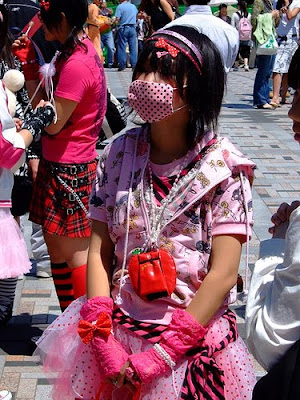 image source
image sourceThink again.
 image source
image source
Imagine how fun it would have been to be a teenager growing up in a culture that encouraged such over the top self-expression and individuality.
 image source
image sourceHarajuku (hara-joo-koo) is the common name for the area around Harajuku Station on the Yamanote Line in Tokyo, Japan where young people gather every Sunday, dressed in a variety of styles that include gothic lolita, visual kei, cosplay (short for costume play), rockabilly, hip-hop, and punk. Beginning in the 80's, the area was closed to traffic on Sundays, and people would gather, play music, and socialize.

image source
Photographer Shoichi Aoki, credited with bringing street fashion to Japan, started a magazine called Street in the 1980's to show Japanese kids the ‘free street art’ of London. Aoki says, "In the mid 90’s it was truly revolutionary when people started to dye their hair and choose their own color. You eventually saw all kinds of colors: green, red, anything.”
He continues,“You had this small group of trendsetters, perhaps 10 to 20 people. Whenever they came up with something new, others would soon imitate them. But these imitators weren’t as cool as the original trendsetters so the trendsetters didn’t want to be identified with them. To differentiate themselves again they came up with new things.
 image source
image sourceBut what do these clothing statements mean? Aoki says there is no social context at all. "Instead of expressing yourself, it is a way of communicating with the members of your group. A message without words. You show your feelings, your awareness of fashion... They don’t care at all about how other people in society or how other groups see them.” (source)
 image source
image sourceSo what are these subsets of Harajuku street fashion?
Goth Lolitas wear black and white, or shades of pastel if they're being "sweet". Lots of knee length or mini dresses gooped-up with crinoline, lace, corsets, ribbons....
 image source
image source image source
image sourceDecora is a style of dress hyper-decorated with tiny toys and plastic jewelry, usually in bright crayola crayon colors. Related, but not as extreme is the Kawaii or "cuteness" style; girls wear clothing that appears to be made for young children, or dress to look "Japanese cute".
 image source
image sourceUltra modern looking punk Visual Kei is inspired by the local music scene, especially punk and rock. The look is often androgynous. This girl is playing the bassist from a japanese rock band. What's with the nose cover? Guess it's his trademark, like MJ's glove in the 80's.
 image source
image source
 image source
image sourceSide note: In many of the photos I browsed through, I noticed many people wear face masks. Some just regular hospital-issue, and others quite elaborate. With a little digging, I discovered these masks are commonplace in Japan.
 image source
image sourceOkay, back to the Harajuku...
The key seems to be layering. Layer, layer, layer. Stripes with polka dots, every color in the rainbow, several pairs of socks... Everything from designer clothes to handmade is mixed and mismatched (key ingredient here) with colorful accessories to create a unique and individual style.
 image source
image source image source
image source
It's even gone rather mainstream, with clothing retailers selling Harajuku "sets'. This one is called the "Harajuku Girl Glamorous Punk Set"
This pop culture trend has actually been quite widely accepted throughout Japan on every level, even seen by some as part of their national identity. image source
image source Want to see more? For even more colorful pictures of Harajuku, check out Shoichi Aoki's books Fruits, Fresh Fruits or his magazine of the same name.
Want to see more? For even more colorful pictures of Harajuku, check out Shoichi Aoki's books Fruits, Fresh Fruits or his magazine of the same name.So the next time you are fretting about being seen in one navy sock and one black, or worry that your shirt might be a bit too colorful, think of the Harajuku kids and be brave!






